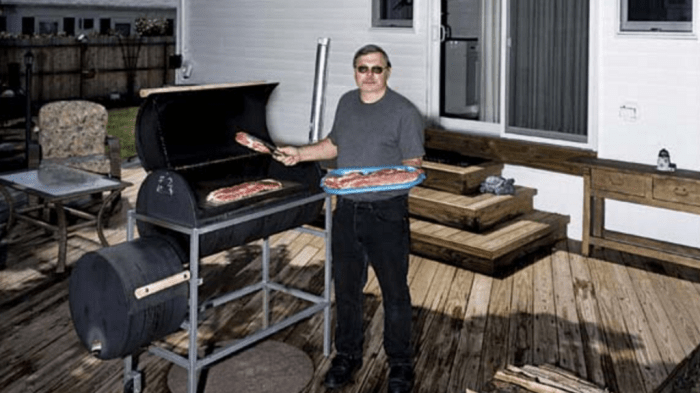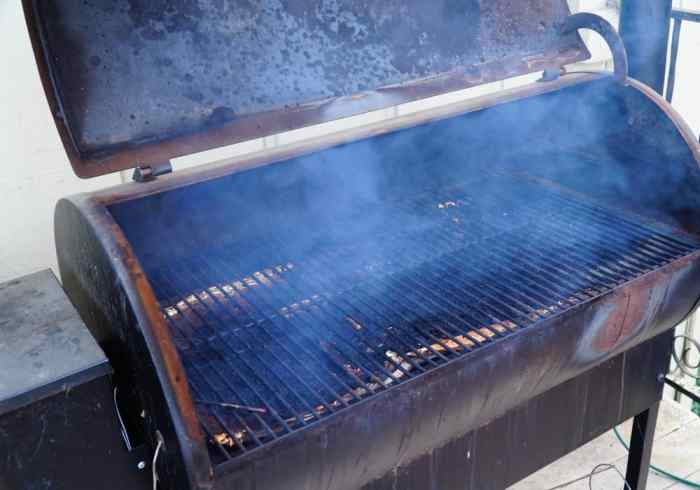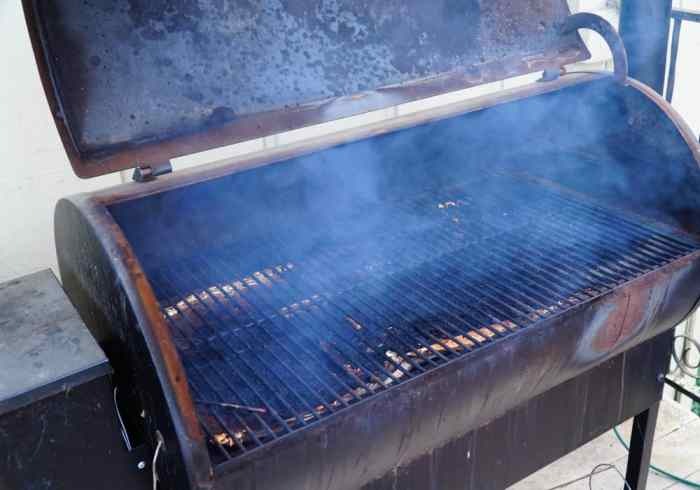DIY pellet grills are gaining popularity as a way to enjoy the benefits of this versatile cooking method without the high cost of a commercial model. Building your own pellet grill can be a rewarding experience, allowing you to customize it to your specific needs and preferences. You’ll learn the fundamentals of pellet grill design and construction, from choosing materials to integrating essential components like the pellet hopper, firebox, and temperature control system.
This comprehensive guide will take you through every step of the process, from planning and design to assembly and testing. We’ll explore the different types of pellet grills available, compare DIY options to commercially available models, and delve into the details of each component, ensuring you have the knowledge and confidence to create your own high-quality pellet grill.
Introduction to DIY Pellet Grills
Building your own pellet grill can be a rewarding experience, allowing you to customize the design and features to perfectly suit your needs and preferences. This DIY approach not only saves you money but also gives you the satisfaction of creating something unique and functional.
The process of constructing a DIY pellet grill involves understanding the basic components and principles of pellet grilling. This includes selecting appropriate materials, designing the structure, and assembling the different parts.
Types of Pellet Grills
Pellet grills come in various sizes and styles, each with its own set of features and benefits. The most common types include:
- Horizontal Pellet Grills: These are the most popular type, featuring a horizontal cooking chamber and a hopper that feeds pellets into the firebox. They are versatile for grilling, smoking, and baking.
- Vertical Pellet Grills: These grills have a vertical cooking chamber, allowing for efficient use of space and a unique vertical smoking experience.
- Offset Pellet Grills: These grills combine the features of traditional offset smokers with the convenience of pellet grilling, offering a wide range of cooking options.
DIY Pellet Grills vs. Commercially Available Options
Building a DIY pellet grill allows for greater control over the design, materials, and features. You can choose the size, shape, and cooking area that best suits your needs, and select high-quality materials that meet your budget.
- Cost: DIY pellet grills can be significantly cheaper than commercially available options, especially if you utilize recycled materials or purchase components in bulk.
- Customization: You have complete control over the design and features of your DIY pellet grill, allowing you to tailor it to your specific cooking preferences and space limitations.
- Learning Experience: Building a DIY pellet grill is a hands-on learning experience, providing you with a deeper understanding of the components and principles involved in pellet grilling.
“While DIY pellet grills offer cost savings and customization, commercially available options often come with pre-engineered designs, built-in safety features, and warranties.”
However, commercially available pellet grills offer convenience and pre-engineered designs, ensuring reliability and safety. They often come with features like temperature control systems, digital displays, and built-in thermometers, making them easier to operate.
Firebox and Pellet Feeding System: Diy Pellet Grill
The firebox and pellet feeding system are the heart of a pellet grill. The firebox is where the pellets are burned to generate heat, and the pellet feeding system controls the rate at which pellets are fed into the firebox, thus regulating the temperature.
Firebox Design and Construction
The firebox is typically made of heavy-duty steel or cast iron, and it is designed to withstand high temperatures. It includes a combustion chamber where pellets are burned, an ash pan to collect ash, and an air intake to regulate airflow. The firebox is also equipped with a heat deflector to distribute heat evenly throughout the cooking chamber.
Pellet Feeding System Operation
The pellet feeding system is responsible for delivering pellets to the firebox at a consistent rate. It usually consists of a hopper that stores pellets, a motor that drives an auger, and a control board that regulates the auger’s speed. The auger feeds pellets into the firebox, and the control board adjusts the auger’s speed based on the desired temperature.
Airflow and Heat Regulation
Proper airflow is crucial for efficient combustion and heat regulation in a pellet grill. The firebox’s air intake allows oxygen to enter the combustion chamber, supporting the burning of pellets. The control board regulates airflow by adjusting the air intake, thus controlling the intensity of the fire and the temperature inside the cooking chamber.
Importance of Proper Airflow and Heat Regulation
Proper airflow ensures complete combustion of pellets, minimizing smoke and maximizing heat output. Heat regulation is critical for maintaining consistent temperatures during cooking, allowing for precise control over the grilling process.
Cooking Chamber and Grill Grates

The cooking chamber is the heart of your pellet grill, where the magic of low-and-slow cooking happens. It’s crucial to design a chamber that distributes heat evenly, ensuring consistent cooking results. Choosing the right materials for the chamber and grill grates is equally important, as they influence heat retention, durability, and ease of cleaning.
Cooking Chamber Design, Diy pellet grill
The design of the cooking chamber plays a critical role in heat distribution. A well-designed chamber will allow hot smoke to circulate evenly, resulting in consistent cooking temperatures throughout.
- Insulation: Insulating the cooking chamber is essential for maintaining consistent temperatures. Common insulation materials include ceramic fiber blankets, high-temperature fiberglass insulation, or even perlite. Insulation helps to prevent heat loss, minimizing temperature fluctuations and ensuring even cooking.
- Airflow: Proper airflow is crucial for efficient heat circulation. A well-designed cooking chamber will have strategically placed vents that allow for controlled airflow, ensuring even heat distribution and smoke circulation. This helps create a consistent environment for cooking, leading to delicious results.
- Shape: The shape of the cooking chamber also influences heat distribution. A rectangular chamber with a larger surface area provides more even heat than a round chamber. This allows for greater flexibility in cooking different types of food, such as large roasts or multiple racks of ribs.
Cooking Chamber Materials
Choosing the right materials for the cooking chamber is essential for durability, heat retention, and ease of cleaning.
- Steel: Steel is a popular choice for cooking chambers due to its durability and heat resistance. Stainless steel is particularly well-suited for pellet grills, as it is corrosion-resistant and can withstand high temperatures. It’s also easy to clean and maintain, ensuring your grill remains in good condition for years to come.
- Cast Iron: Cast iron is another excellent option for cooking chambers, known for its exceptional heat retention and durability. It heats up slowly but retains heat for long periods, making it ideal for low-and-slow cooking. Cast iron is also naturally non-stick, which can make cleaning easier. However, it can be susceptible to rust if not properly seasoned and maintained.
Grill Grates
Grill grates are essential for holding your food while it cooks. They come in various materials and designs, each with its own benefits and drawbacks.
- Grill Grate Placement: The placement of the grill grates is critical for optimal cooking. They should be positioned at a height that allows for proper heat circulation and ensures even cooking. Ideally, the grill grates should be placed in a position that allows for consistent airflow around the food, ensuring even heat distribution and preventing hot spots.
- Grill Grate Material: Choosing the right material for your grill grates is important. Common materials include:
- Cast Iron: Cast iron grill grates are known for their excellent heat retention and durability. They can withstand high temperatures and provide even heat distribution, resulting in delicious grill marks. However, they can be heavy and require proper seasoning and maintenance to prevent rust.
- Stainless Steel: Stainless steel grill grates are a popular choice due to their durability and corrosion resistance. They are easier to clean than cast iron and generally require less maintenance. However, they may not retain heat as well as cast iron and might not produce as strong grill marks.
- Porcelain-coated Steel: Porcelain-coated steel grill grates offer the durability of steel with a non-stick coating, making them easier to clean. They are also less prone to rust than bare steel. However, the porcelain coating can chip over time, requiring replacement.
Temperature Control and Monitoring
Maintaining a consistent temperature is crucial for successful grilling. This section will discuss how to design and calibrate a temperature control system, as well as various methods for monitoring the grill’s temperature during cooking.
Temperature Control System Design
A basic temperature control system for a pellet grill typically consists of a thermostat, a fan, and a temperature sensor. The thermostat acts as the brain of the system, regulating the fan’s speed to maintain the desired temperature. The fan, usually a small DC fan, controls airflow through the firebox, thereby regulating the heat output. The temperature sensor, usually a thermocouple, monitors the temperature inside the cooking chamber and sends this information to the thermostat.
- The thermostat monitors the temperature sensor reading and compares it to the setpoint temperature. If the temperature is below the setpoint, the thermostat will increase the fan speed, allowing more air into the firebox and increasing the heat output. Conversely, if the temperature is above the setpoint, the thermostat will decrease the fan speed, reducing airflow and lowering the heat output.
- The fan is responsible for controlling the airflow through the firebox, which directly influences the heat output. A faster fan speed means more air is being drawn into the firebox, resulting in a hotter fire. Conversely, a slower fan speed means less air is being drawn into the firebox, resulting in a cooler fire.
- The temperature sensor is usually a thermocouple, which is a device that converts temperature into an electrical signal. The thermocouple is placed inside the cooking chamber to monitor the temperature accurately. The thermostat uses this signal to determine the current temperature and adjust the fan speed accordingly.
Temperature Control System Calibration
Calibrating the temperature control system is essential to ensure accurate temperature readings and consistent cooking results. This involves adjusting the thermostat’s setpoint to match the actual temperature inside the cooking chamber.
- The calibration process typically involves using a reliable thermometer, such as a digital meat thermometer or an infrared thermometer, to measure the temperature inside the cooking chamber at various setpoint temperatures.
- Compare the readings from the reliable thermometer with the readings from the temperature sensor connected to the thermostat. Adjust the thermostat’s setpoint accordingly to match the actual temperature.
- For example, if the thermostat’s setpoint is 225°F but the actual temperature inside the cooking chamber is 200°F, you would need to increase the thermostat’s setpoint by 25°F to achieve the desired cooking temperature.
Grill Temperature Monitoring
Monitoring the grill temperature during cooking is essential for maintaining consistent heat and ensuring food cooks evenly. Here are several methods for monitoring grill temperature:
- Built-in Temperature Gauge: Many pellet grills come equipped with a built-in temperature gauge that displays the temperature inside the cooking chamber. While convenient, these gauges may not always be accurate, so it’s recommended to use a separate thermometer for verification.
- Digital Meat Thermometer: A digital meat thermometer is a reliable and accurate way to monitor the grill temperature. Simply place the thermometer probe inside the cooking chamber, away from direct heat, and monitor the temperature reading.
- Infrared Thermometer: An infrared thermometer, also known as a laser thermometer, measures the temperature of a surface by detecting its infrared radiation. This is a quick and convenient method for monitoring the grill temperature, but it may not be as accurate as a digital meat thermometer.
- Remote Temperature Monitoring: Some advanced pellet grills offer remote temperature monitoring capabilities, allowing you to monitor the grill temperature from your smartphone or tablet. This feature is particularly useful for long cooks or when you need to monitor the temperature from a distance.
Recipes and Cooking Techniques

Pellet grills are known for their versatility and ability to produce delicious results. Whether you’re a seasoned grill master or just starting out, this section will guide you through some popular recipes and techniques specific to pellet grilling.
Pellet Grill Recipes
Pellet grills excel at low-and-slow cooking, making them perfect for barbecue, smoking, and roasting. Here are some popular recipes that showcase the versatility of pellet grills:
- Smoked Ribs: This classic barbecue staple requires a long, slow cook to achieve tender, fall-off-the-bone ribs. Pellet grills provide consistent heat and smoke for the perfect result.
- Pulled Pork: Another barbecue favorite, pulled pork is best cooked low and slow on a pellet grill. The smoke infuses the pork with a rich, smoky flavor.
- Smoked Chicken: Pellet grills are excellent for smoking whole chickens, resulting in juicy, flavorful meat with crispy skin.
- Roasted Vegetables: The even heat of a pellet grill makes it ideal for roasting vegetables. Try roasting root vegetables like carrots, potatoes, and onions for a flavorful side dish.
- Pizza: Yes, you can even make pizza on a pellet grill! The high heat and controlled environment create a crispy crust with a delicious smoky flavor.
Cooking Techniques
Pellet grills offer a variety of cooking techniques, allowing you to experiment with different flavors and textures.
Low and Slow Cooking
Low and slow cooking is a hallmark of pellet grilling. This technique involves cooking food at low temperatures (typically between 225°F and 275°F) for extended periods. This method breaks down tough cuts of meat, resulting in tender, flavorful results.
Low and slow cooking is ideal for achieving tender, flavorful results with tougher cuts of meat.
Smoking
Pellet grills are excellent for smoking meat. The wood pellets release smoke that infuses the food with a distinctive flavor.
- Smoke Levels: The amount of smoke produced can be adjusted by controlling the pellet feed rate. A higher feed rate will produce more smoke, while a lower feed rate will produce less smoke.
- Smoke Flavors: Different wood pellets produce different smoke flavors. For example, hickory pellets impart a strong, smoky flavor, while applewood pellets provide a milder, sweeter flavor.
Grilling
Pellet grills can also be used for grilling. The high heat and controlled environment create a perfect sear on steaks, burgers, and other grilled items.
Pellet grills can achieve high temperatures for searing, making them versatile for both low and high-heat cooking.
Roasting
The even heat of a pellet grill makes it ideal for roasting. Roasting large cuts of meat or whole poultry results in juicy, flavorful results.
Roasting on a pellet grill produces juicy, flavorful results due to the even heat distribution.
With a little time, effort, and the right tools, you can build a DIY pellet grill that will provide years of delicious and satisfying cooking experiences. Whether you’re a seasoned grill master or a novice cook, the process of building your own pellet grill is an adventure that will teach you valuable skills and allow you to customize your cooking setup to your exact specifications. Enjoy the journey of creating your own backyard culinary masterpiece!
Building a DIY pellet grill is a fun and rewarding project, especially if you enjoy spending time outdoors. However, those warm summer nights can be plagued by pesky mosquitoes. To combat them, consider making your own natural mosquito repellent using essential oils and other safe ingredients. You can find a great guide on mosquito repellent diy to help you keep those bugs away while you’re grilling up delicious meals on your DIY pellet grill.

